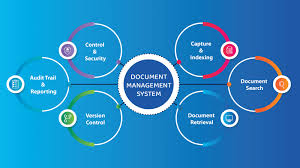
The Benefits of a Paperless Management System
In today’s digital age, businesses are increasingly turning to paperless management systems to streamline their operations and reduce their environmental footprint. A paperless management system involves the digitization of documents, processes, and workflows, eliminating the need for physical paper records.
One of the key benefits of a paperless management system is improved efficiency. By storing documents electronically, employees can easily access and share information in real-time, leading to faster decision-making and increased productivity. Gone are the days of searching through filing cabinets or waiting for documents to be physically transported between departments.
Furthermore, a paperless management system promotes cost savings for businesses. With reduced printing, storage, and distribution expenses, organizations can allocate resources more effectively towards core business activities. Additionally, digital documents are less prone to loss or damage compared to their paper counterparts, ensuring data security and integrity.
From an environmental perspective, implementing a paperless management system contributes to sustainability efforts by reducing paper consumption and waste generation. By going digital, businesses can minimize their carbon footprint and demonstrate a commitment to eco-friendly practices.
Moreover, a paperless management system enhances regulatory compliance by facilitating document tracking and audit trails. With features such as version control and access controls, organizations can ensure that sensitive information is securely managed and monitored according to industry standards.
In conclusion, transitioning to a paperless management system offers numerous advantages for businesses seeking operational efficiency, cost savings, environmental stewardship, and regulatory compliance. Embracing digital transformation not only modernizes business processes but also positions organizations for long-term success in an increasingly digital world.
Top 6 FAQs About Paperless Management Systems and Their Benefits
- What is a paperless management system?
- How does a paperless management system improve efficiency?
- What are the cost-saving benefits of implementing a paperless management system?
- How does a paperless management system contribute to environmental sustainability?
- What features should I look for in a paperless management system?
- How can a paperless management system enhance regulatory compliance?
What is a paperless management system?
A paperless management system refers to a digital platform or software solution that enables organizations to eliminate the use of physical paper in their day-to-day operations. By digitizing documents, processes, and workflows, a paperless management system streamlines information access, sharing, and storage, leading to improved efficiency, cost savings, and environmental sustainability. This technology allows businesses to transition from traditional paper-based record-keeping to electronic document management, facilitating real-time collaboration, data security, and regulatory compliance. Ultimately, a paperless management system revolutionizes how organizations manage information by leveraging digital tools to enhance productivity and streamline business processes.
How does a paperless management system improve efficiency?
A paperless management system enhances efficiency by digitizing documents and processes, enabling easy access, sharing, and retrieval of information in real-time. By eliminating the need for physical paper records, employees can quickly locate and work with documents without the constraints of traditional filing systems. This streamlined workflow accelerates decision-making processes, boosts productivity, and reduces time spent on manual tasks such as searching through paper files or waiting for document transfers between departments. Overall, the digitization of information in a paperless management system optimizes operational efficiency by providing a centralized, organized, and easily accessible repository of data that empowers employees to work more effectively and collaboratively.
What are the cost-saving benefits of implementing a paperless management system?
Implementing a paperless management system offers significant cost-saving benefits for businesses. By transitioning to digital document storage and workflows, organizations can reduce expenses associated with printing, paper supplies, storage space, and document distribution. Additionally, the streamlined access to electronic documents leads to time savings for employees, increasing overall productivity and operational efficiency. Furthermore, the decreased reliance on paper-based processes minimizes the risk of errors and losses, ultimately contributing to long-term cost reductions and improved financial sustainability for businesses embracing paperless management systems.
How does a paperless management system contribute to environmental sustainability?
A paperless management system contributes significantly to environmental sustainability by reducing paper consumption and minimizing waste generation. By digitizing documents and workflows, organizations can significantly decrease their reliance on paper, thus conserving valuable natural resources like trees and water. Additionally, the shift to digital processes reduces the need for printing, cutting down on energy consumption and greenhouse gas emissions associated with traditional printing methods. Furthermore, by eliminating physical paper records, businesses can reduce their carbon footprint by decreasing transportation-related emissions and lowering the amount of waste sent to landfills. Overall, embracing a paperless management system not only enhances operational efficiency but also demonstrates a commitment to eco-friendly practices that help protect the environment for future generations.
What features should I look for in a paperless management system?
When considering a paperless management system, it is essential to look for key features that align with your organization’s needs and objectives. Some important features to consider include robust document storage and retrieval capabilities, seamless integration with existing software systems, user-friendly interface for easy adoption, advanced security measures to protect sensitive data, customizable workflows to streamline processes, automated notifications and reminders for efficient task management, and comprehensive reporting tools for monitoring performance and compliance. By evaluating these features in a paperless management system, you can ensure a successful transition to a digital environment that enhances productivity and effectiveness across your organization.
How can a paperless management system enhance regulatory compliance?
A paperless management system can enhance regulatory compliance by providing robust document tracking and audit capabilities. With digital documents stored in a centralized system, organizations can easily monitor access controls, track document versions, and maintain comprehensive audit trails. This level of transparency and accountability ensures that sensitive information is securely managed in accordance with regulatory requirements. Furthermore, automated workflows and notifications within a paperless management system help streamline compliance processes, reducing the risk of errors or oversights. By leveraging the features of a paperless management system, businesses can demonstrate adherence to industry regulations and standards while mitigating compliance risks effectively.
